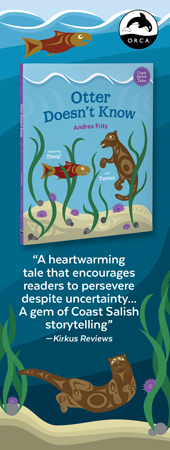A “Gone Viking” excursion … in BC
EXCERPT: "Gone Viking III: The Holy Grail" by Bill Arnott.
June 06th, 2023

Bill Arnott's Viking expeditions have earned him a Fellowship at London’s Royal Geographical Society.
Arnott’s series of travel memoirs retracing Viking journeys all lead back to British Columbia where he sees similarities in Indigenous communities. Boat materials and routes vary but all have “an eye to an endless horizon,” he explains here.
Following two decades of travel I was back in Canada, to conclude the Gone Viking travelogues with my latest memoir, Gone Viking III: The Holy Grail (RMBooks $30) [due out October, 2023]. And while this expedition took me across Europe, Scandinavia and the Arctic, once again it was anchored in British Columbia.
Much of my motivation to undertake these overseas odysseys began in brushstrokes of art. Inspiration from stylized maps and a painting of the ocean-going canoe named Loo Taas: fifteen metres of red cedar, Haida design and construction, conceived by Bill Reid, my depiction of that craft a painting by Robert Bateman.

Robert Bateman painting of Bill Reid’s hand carved, ocean-going canoe, Loo Taas. Photo by Bill Arnott.
Eventually I would go to Haida Gwaii to see and touch that canoe, what I knew as an image on canvas coming to life. A surreal moment. Spiritual too. For what I saw in the hand-carved cedar was more than a boat. It was a time capsule, powered by paddles and heritage. I saw, in a manner, an Indigenous longship, akin to those oaken Norse boats with striped sails that crossed the Atlantic to find Newfoundland, land of the Mi’kmaq and Innu. The wood varied, the people and routes, but what remained was shared vision, an eye to an endless horizon.
To my pleasant surprise I saw two of those famous canoes, as a replica was set on display while the original was being restored. From the Loo Taas doppelganger I made my way to a carving shed by the Haida Heritage Centre at Ḵay Llnagaay, where an artisan worked on red cedar, the same fragrant wood as the boat. He too was constructing a totem, a moiety family tree, to take its place among kin near the water. A totemic line touching sky while watching the sea.
Wingbeats faded as the raven vanished from view, the eagles stayed where they were, and water lapped at the shore. The carver, meanwhile, returned to his work, the melodic score now including the soft sound of chisel on cedar.
With those sounds resonating I made my way into forest, site of the felled Golden Spruce. The trek both homage and pilgrimage. And I thought of the slab of the trunk that was blessed by Elders and Chiefs to construct the Voyageur guitar. The heart of a tree crossing multiple nations, to be held, passed and played, by thousands of people who live on this land. Again, an elimination of time, and of place. People and sharing becoming the glair.

Bill Arnott beside the Golden Spruce Voyageur guitar.
Another blur of geography and I’m gazing at Vancouver shoreline, where another hand-carved wood vessel once sailed. A Viking Ship, seemingly out of place, and yet precisely where it should be. Not housed in a museum but free to touch and taste the salt air, much like the Loo Taas canoe. The Norse ship I saw is called Munin. Same as a raven that would perch on a shoulder of Odin. The name of the bird and the ship meaning memory.
Apt enough, as I felt memory renewed when I boarded the namesake longship, part of a wooden boat festival held by the Granville Street Bridge. The moment I set foot on the craft I was transported back to that carving shed, again hearing chisel on wood. Only this time the aroma of resin and wood meshed with a groan of sail-rope and hawser. In the same way I believed the red cedar on Haida Gwaii longed to stand among fellow totems, so too did I sense that the Munin, like Loo Taas, couldn’t wait to set sail, to taste open water. The allure of waves and horizon.
 Another time warp and I find myself in a welcoming group at Burnaby’s Scandinavian Cultural Centre. And to my delight I’m introduced to Kris Frostad, builder of Norwegian boats and the artisan who constructed the Munin. As though meeting Bill Reid, Robert Bateman, Odin and his raven as well. Naturally, we spoke of carving and history, and his boat that he named for that raven. All of it a sharing of art and of history, common ground in a place without borders.
Another time warp and I find myself in a welcoming group at Burnaby’s Scandinavian Cultural Centre. And to my delight I’m introduced to Kris Frostad, builder of Norwegian boats and the artisan who constructed the Munin. As though meeting Bill Reid, Robert Bateman, Odin and his raven as well. Naturally, we spoke of carving and history, and his boat that he named for that raven. All of it a sharing of art and of history, common ground in a place without borders.
His smile was warm, contagious, and the glasses he wore caught the light much like sun on the water. Building the boat, he explained, never felt like a job. Nor did he work from set plans. “Just go by feel. And I loved doing it,” he said, another infectious grin. It was the same energy exuded by the carver in Haida Gwaii. The skill of a true artisan. Doing what each was inherently meant to do. Shared vision, embarking on artistic odysseys, a version of endless horizons.
Frostad’s boat has retired, now on display at the Cultural Centre. But in the same way I believed I still heard the soft rasp of chisel on cedar, I’m sure my new friend could imagine saltwater still touching the hull of his ship, gusts of wind in a striped cotton sail. As we finished our meal sun slowly set, as though ending scene, drawing a curtain on imagery. I envisioned his ship blurred in spindrift and mist, like the last of an artisan’s age. A totemic boat, history of having Gone Viking, recollection of shoreline and sea.
9781771606462
***
 Bill Arnott is the bestselling author of the Gone Viking travel memoirs (Gone Viking: A Travel Saga, Gone Viking II: Beyond Boundaries, Gone Viking III: The Holy Grail) and A Season on Vancouver Island. He’s won numerous literary awards and for his expeditions been granted a Fellowship at London’s Royal Geographical Society. When not trekking the globe with a small pack and journal, Bill can be found on Canada’s west coast, where he lives near the sea on Musqueam, Squamish, and Tsleil-Waututh land.
Bill Arnott is the bestselling author of the Gone Viking travel memoirs (Gone Viking: A Travel Saga, Gone Viking II: Beyond Boundaries, Gone Viking III: The Holy Grail) and A Season on Vancouver Island. He’s won numerous literary awards and for his expeditions been granted a Fellowship at London’s Royal Geographical Society. When not trekking the globe with a small pack and journal, Bill can be found on Canada’s west coast, where he lives near the sea on Musqueam, Squamish, and Tsleil-Waututh land.


Leave a Reply